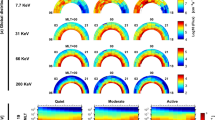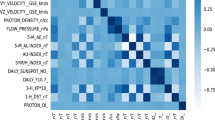Abstract
High-energy electron flux increases in the recovery phase after the space weather events such as a coronal mass ejection. High-energy electrons can penetrate circuits deeply and the penetration could lead to deep dielectric charging. The forecast of high-energy electron flux is vital in providing warning information for spacecraft operations. We investigate an adaptive predictor based on ADALINE neural network. The predictor can forecast the trend of the daily variations in high-energy electrons. The predictor was trained with the dataset of ten years from 1998 to 2008. We obtained the prediction efficiency approximately 0.6 each year except the first learning year 1998. Furthermore, the predictor can adapt to the changes for the satellite’s location. Our model succeeded in forecasting the high-energy electron flux 24 hours ahead.
Preview
Unable to display preview. Download preview PDF.
Similar content being viewed by others
References
Baker, D.N., Kanekal, S., Blake, J.B., Klecker, B., Rostoker, G.: Satellite anomalies linked to electron increase in the magnetosphere. EOS Transactions 75, 401–405 (1994)
Baker, D.N.: Satellite Anomalies due to Space Storms. In: Daglis, I.A. (ed.) Space Storms and Space Weather Hazards, pp. 285–311 (2001)
Liemohn, M.W., Chan, A.A.: Unraveling the Causes of Radiation Belt Enhancements. EOS Transactions 88, 425–426 (2007)
Kataoka, R., Miyoshi, Y.: Flux Enhancement of Radiation Belt Electrons during Geomagnetic Storms Driven by Coronal Mass Ejections and Corotating Interaction Regions. Space Weather 4, S09004 (2004)
Baker, D.N., McPherron, R.L., Cayton, T.E., Klebesadel, R.W.: Linear Prediction Filter Analysis of Relativistic Electron Properties at 6.6 Re. J. Geophys. Res. 95(A9), 15133–15140
Baker, D.N., Klebesadel, R.W., Higbie, P.R., Blake, J.B.: Highly Relativistic Electrons in the Earth’s Outer Magnetosphere. I - Lifetimes and Temporal History 1979-1984. J. Geophys. Res. 91, 4265–4276 (1986)
Koons, H.C., Gorney, D.J.: A Neural Network Model of the Relativistic Electron Flux at Geosynchronous Orbit. J. Geophys. Res. 96, 5549–5556 (1991)
Ardalani, N., Khoogar, A., Roohi, H.: A Comparison of ADALINE and MLP Neural Network-based Predictors in SIR Estimation in Mobile DS/CDMA Systems. Computing and Technology 9, 145–150 (2005)
Fukata, M., Taguchi, S., Okuzawa, T., Obara, T.: Neural network prediction of relativistic electrons at geosynchronous orbit during the storm recovery phase: effects of recurring substorms. Annales Geophysicae 20, 947–951 (2002)
Watari, S., Tokumitsu, M., Kitamura, K., Ishida, Y.: Forecast of High-energy Electron Flux at Geostationary Orbit Using Neural Network. In: The 26th International Symposium on Space Technology and Science, ISTS 2008 (2008)
Widrow, B., Lehr, M.A.: Perceptrons, adalines, and backpropagation. The handbook of brain theory and neural networks, 719–724 (1998)
Ishida, Y.: Designing an Immunity-Based Sensor Network for Sensor-Based Diagnosis of Automobile Engines. In: Gabrys, B., Howlett, R.J., Jain, L.C. (eds.) KES 2006. LNCS (LNAI), vol. 4252, pp. 146–153. Springer, Heidelberg (2006)
King, J.H., Papitashvili, N.E.: Solar wind spatial scales in and comparisons of hourly Wind and ACE plasma and magnetic field data. J. Geophys. Res (Space Physics) 110(A9), A02104 (2005)
Author information
Authors and Affiliations
Editor information
Editors and Affiliations
Rights and permissions
Copyright information
© 2009 Springer-Verlag Berlin Heidelberg
About this paper
Cite this paper
Tokumitsu, M., Ishida, Y., Watari, S., Kitamura, K. (2009). Adaptive Forecasting of High-Energy Electron Flux at Geostationary Orbit Using ADALINE Neural Network. In: Velásquez, J.D., Ríos, S.A., Howlett, R.J., Jain, L.C. (eds) Knowledge-Based and Intelligent Information and Engineering Systems. KES 2009. Lecture Notes in Computer Science(), vol 5712. Springer, Berlin, Heidelberg. https://doi.org/10.1007/978-3-642-04592-9_99
Download citation
DOI: https://doi.org/10.1007/978-3-642-04592-9_99
Publisher Name: Springer, Berlin, Heidelberg
Print ISBN: 978-3-642-04591-2
Online ISBN: 978-3-642-04592-9
eBook Packages: Computer ScienceComputer Science (R0)




